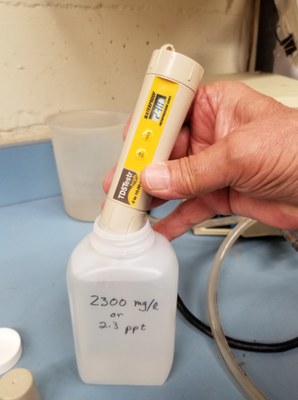Water contains dissolved minerals, which are commonly referred to as total dissolved solids (TDS) or sometimes as total dissolved salts. The amount of TDS depends on the water’s location and source. Some of the TDS can be toxic if present at concentrations beyond recommended levels.
The standard method for measuring TDS is evaporating all the water from a 0.1-liter sample and weighing the residual minerals left in the vessel. However, collecting a sample and conducting a standard laboratory analysis or sending the sample to a water quality testing facility can be time-consuming.
An electrical conductivity (EC) or TDS meter is a quick method to estimate TDS. Water conducts electricity due to the presence of minerals (ions), so the more dissolved minerals, the more conductive the water becomes. Pure (distilled) water is a poor conductor of electricity, because it contains very few dissolved minerals.
The units for TDS are usually expressed as milligrams per liter (mg/L), which is the same as parts per million (ppm). Some TDS meters also show parts per thousand (ppt), which is equal to 1,000 ppm.
The EC is a proxy measurement to determine the TDS in water. Some of the confusion with using EC is that it can be expressed in different units. The units might be referenced as micromhos per centimeter (μmhos/cm) and millimhos per centimeter (mmhos/cm) or microSeimens per centimeter (μS/cm) and milliSeimens per centimeter (mS/cm). All these units present the same information just expressed differently. For example, 1 mmho/cm = 1 mS/cm = 1,000 μmhos/cm = 1,000 μS/cm.
Most EC meters can change modes to read salinity in grams per liter, EC in μS and TDS in mg/Lor ppt. The meter calculates an estimate of TDS by multiplying the EC reading with a conversion factor. The chart below presents the conversion factor, which increases with increase in conductivity.
To ensure an accurate reading, EC meters must be calibrated regularly. The accuracy of the EC meter should be checked with a calibration solution prior to sampling. Calibrate each time batteries are changed or after the meter has been dropped on a hard surface.
Use a manufacturer-supplied calibration solution to calibrate the instrument, but you can make your own calibration solution using table salt (NaCl) following the instructions below.
| Electrical Conductivity | Approximate TDS | Conversion Factor1 |
|---|
| μmhos/cm | mmhos/cm | μS/cm | mS/cm | mg/l or ppm |
|---|
| 100 | 0.1 | 100 | 0.1 | 50 | 0.50 |
| 500 | 0.5 | 500 | 0.5 | 300 | 0.60 |
| 1,000 | 1.0 | 1,000 | 1.0 | 650 | 0.65 |
| 1,500 | 1.5 | 1,500 | 1.5 | 1,050 | 0.70 |
| 2,000 | 2.0 | 2,000 | 2.0 | 1,450 | 0.72 |
| 2,500 | 2.5 | 2,500 | 2.5 | 1,850 | 0.74 |
| 3,000 | 3.0 | 3,000 | 3.0 | 2,250 | 0.75 |
| 3,500 | 3.5 | 3,500 | 3.5 | 2,650 | 0.76 |
| 4,000 | 4.0 | 4,000 | 4.0 | 3,050 | 0.77 |
| 4,500 | 4.5 | 4,500 | 4.5 | 3,500 | 0.78 |
| 5,000 | 5.0 | 5,000 | 5.0 | 3,950 | 0.79 |
| 6,000 | 6.0 | 6,000 | 6.0 | 4,740 | 0.79 |
| 6,500 | 6.5 | 6,500 | 6.5 | 5,135 | 0.79 |
| 7,000 | 7.0 | 7,000 | 7.0 | 5,600 | 0.80 |
| 8,000 | 7.5 | 7,500 | 7.5 | 6,075 | 0.81 |
| 10,000 | 10.0 | 10,000 | 10.0 | 8,200 | 0.82 |
1 - Conversion factor is for natural waters

